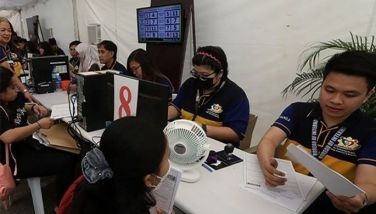Digital TV is for the masa

There is a digital divide in this country that is also an unfortunate social divide. It separates those who can afford cable television subscription and those who rely on those ancient rabbit ear/aerial antennas.
No more than a million Filipinos subscribe to cable television. So, over 90 million Filipinos suffer poor reception, grainy pictures and choppy audio. They are also denied the abundance of channel choices the rich folks get with cable television.
When ABS-CBN conducted digital television (DTV) trials in more than 1,000 households all over the Philippines, the residents raved about the impeccable picture and sound quality and were thrilled with the wider array of programs. One mother who tested the digibox for a week tried to convince the ABS-CBN team to sell it to her. She did not want to return it because her whole family was hooked and loved the service.
What exactly is digital television or DTV? It is a new technology that uses digital transmission– an evolution from the age-old analog technology. DTV requires the use of a digital set-top box (digibox) that would enable even old model television sets to receive the digital signal from the broadcast stations. The DTV digibox has been developed to work with the different kinds of TV sets found in the Philippines. Old, new, surplus TV will all get digital quality picture and sound with the DTV digibox.
Because the digital signal uses less space in the spectrum, every television station can potentially broadcast five channels simultaneously for free. It all depends on the capability of the TV station to produce the content to show on more channels. In the case of ABS-CBN, they have announced that they are ready with five free new channels: two channels for kids, a channel for the youth, a channel for dads and a channel for moms on top of Channel 2 and Studio 23.
But can low income families afford to buy the digibox? This is also the concern of National Telecoms Commission (NTC) and a major consideration in their decision on which system to choose, Japanese or European. The cost will likely be subsidized by the competing networks as well as the vendors of the adopted system.
Once we move up into the digital age for television broadcasting, we will join some 52 countries that have adopted DTV technology. These would include the US, China, Japan, Australia, South Korea, Luxembourg, the Netherlands, Finland, Sweden, Norway, Switzerland, Germany, Spain and Denmark.
Actually the major networks are now producing their programs using digital technology but have to broadcast using the old analog technology because that is still where we are now. That is really such a waste. And it is also rather Third World.
If digital technology is so good, how come it is taking too long to launch?
Well, government started looking at it more than three years ago. What’s holding it up is the time it is taking government to pick a standard for DTV for the country. There are two competing standards, the European and the Japanese. Both standards have their plus and minuses and the NTC is supposed to study and recommend to P-Noy which one to choose.
According to NTC Commissioner Liel Cordoba, they have just about made up their minds to recommend the Japanese system. In fact, they chose it as early as 2010 but decided to review the new upgraded European system just to make sure they are making the right choice.
Right now, Cordoba said NTC is working with the DOST and an industry technical working group in making a plan that will painlessly shift the country’s television broadcasts from analog to digital. Cordoba said they have done their homework and if they get the go signal from P-Noy within the next couple of months, television viewers all over the country will be watching their favorite shows in clear digital format by Christmas.
According to Cordoba, all things considered, the NTC and the KBP are endorsing the Japanese system while GMA 7 (a non-KBP member) is in favor of the European system. While the European system is technically somewhat more advanced, the cost of the digibox at about P1,500 is almost double the cost of the Japanese digibox at about P880.
Furthermore, the Japanese Government committed to set the price of the digibox at a maximum of $10.98 or about half the market price. The Japanese also offered to manufacture the digibox in Sharp Philippines, creating some 7000 jobs in the country. The Europeans could not make a similar offer.
The lower cost of the Japanese digibox means that the take-up by the public of Digital Television will be faster as the consumers will find the Japanese digibox more affordable. The Japanese also offered extras that the Europeans cannot match owing to the difficulties in the European economy these days.
The Japanese government committed to send Japanese experts and engineers to assist our government and the broadcasters in the shift from analog to Digital TV. They also committed to bring Filipino engineers to Japan for training. The EU did not make any such offer.
The Japanese government also offered to work-out soft-loans for the broadcasters in their acquisition of new Digital Television equipment and exempted us from patent payments for digibox components. The Japanese Government is also offering to assist NBN Channel 4 through Official Development Assistance for the installation of digital equipment. The Japanese has also already supplied $4 million worth of equipment to NBN.
The other important feature of the Japanese system, according to Cordoba, is the inclusion of an Early Warning System (EWS). This means, in an emergency, a warning can be delivered to homes through the digibox. This feature has been tested in emergency situations in Japan including earthquakes and tsunamis. This is not a standard feature of the European system.
It seems to me that the earlier the decision is made to go digital television, the better it is for the country. It is also a low hanging fruit, an achievement that the P-Noy administration can quickly claim as part of its program to improve our communication infrastructure to first world standards. It also impacts well on the masa who will be enabled to watch their telenovelas and favorite movies in a high quality transmission that only cable subscribers now enjoy.
How fast the country shifts to Digital Television should not be made part of the kapamilya vs kapuso network wars nor the competition between the Japanese or European systems. It should happen quickly because the masa deserves to have it. The digital divide must be erased.
If the intense competition on which system to use is a hindrance to a quick decision, we may even go on an open system which allows networks to choose what they want. The problem with this is that it will require households to buy two digiboxes instead of just one.
But even that is not so bad because consumers can choose to just have one. The market will decide which system it wants and government cannot be accused of favoring one or the other for ZTE reasons, if you know what I mean.
NTC’s Cordoba said they are ready to implement as soon as P-Noy says go. Hopefully that happens quickly because all the other impact projects will likely take time if the pace of DOTC projects is any indication. This one can happen right away and with very little cost from the government, if at all.
Digital Television is essentially for the masa… for the masa to enjoy for free what the elite already enjoy but pay for. Given how tough their lives already are, the masa’s enjoyment of this modern technology shouldn’t be denied them with further delay. Who knows, it may even help moderate our population growth without violating the principles of the Church if they spend more of their evening hours watching digital television rather than the other pastime.
Millionaire
Rosan Cruz sent this one.
A convention of successful entrepreneurs was being covered by a television news team. The young reporter, wanting to hear words of wisdom to inspire viewers, approached a successful looking businessman.
Reporter: Sir, you look like a millionaire.
Businessman: Oh, I have had my ups and downs.
Reporter: What or who is the secret of your being a millionaire?
Businessman: My wife.
Reporter: Really sir? What were you before you met your wife?
Businessman: A billionaire.
Boo Chanco’s e-mail address is [email protected]. Follow him on Twitter @boochanco
- Latest
- Trending






























